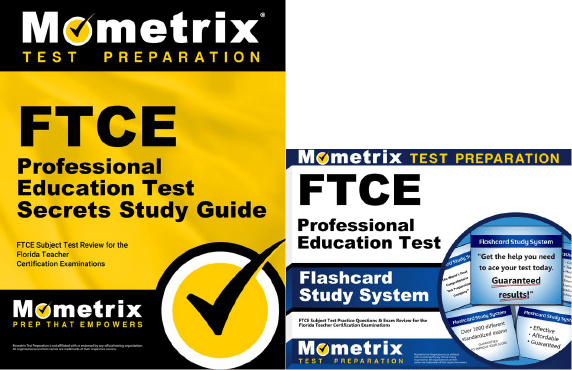If you need help studying for the FTCE Professional Education test or just want some more information about what the test is like, you’ve come to the right place!
Click below to take a free FTCE Professional Education practice test!
What’s on the Test?
The FTCE Professional Education test contains 80 multiple-choice questions and is timed at 2.5 hours.
The exam is split into eight competencies:
1. INSTRUCTIONAL DESIGN AND PLANNING
18% of the exam
- Selecting a variety of instructional practices, materials, and technologies that foster critical, creative, and reflective thinking aligned with state-adopted standards
- Choosing appropriate methods, strategies, and evaluation instruments for assessing and monitoring student performance levels, needs, and learning
- Determining and applying learning experiences and activities that require students to demonstrate a variety of applicable skills and competencies
- Identifying instructional resources based on measurable objectives, individual student learning needs, and performance levels
- Applying learning theories to instructional design and planning
- Determining long-term instructional goals and short-term objectives appropriate to student learning needs and performance levels aligned with state-adopted standards
- Selecting and using culturally responsive instructional materials and practices in planning
- Selecting lessons and concepts that are sequenced to activate prior knowledge and ensure coherence among the lessons
- Identifying patterns of physical, social, and academic development to differentiate instructional design for student mastery
- Determining and applying appropriate intervention strategies based on individual student needs and data
2. APPROPRIATE STUDENT-CENTERED LEARNING ENVIRONMENTS
15% of the exam
- Using appropriate techniques to organize, allocate, and manage time, space, and attention resources in various learning environments
- Applying strategies and procedures to manage individual student behaviors and group dynamics effectively
- Communicating high expectations to all students using effective techniques
- Adapting the learning environment to meet the needs and backgrounds of all students
- Modeling appropriate oral and written communication skills using relevant techniques
- Encouraging innovation and fostering a safe climate of openness, inquiry, equity, and support for all students
- Utilizing information and communication technologies to maintain a student-centered learning environment
- Identifying assistive technologies to help all students communicate effectively and achieve their educational goals
3. INSTRUCTIONAL DELIVERY AND FACILITATION
18% of the exam
- Using motivational strategies to engage and challenge all students
- Applying instructional practices for developing content area literacy
- Analyzing gaps in students’ knowledge to improve instructional delivery
- Assessing and adapting instruction to address preconceptions and misconceptions about subject matter
- Relating subject matter to life experiences and across disciplines
- Developing higher-order critical thinking skills using various techniques
- Selecting varied strategies, resources, and technology for relevant and comprehensible instruction
- Identifying differentiated instructional practices based on learning needs, individual differences, and continuous feedback
- Providing feedback to promote student achievement using appropriate techniques
- Applying subject area activities to accommodate the learning needs, developmental levels, and experiential backgrounds of all students
4. ASSESSMENT STRATEGIES FOR DETERMINING IMPACT ON STUDENT LEARNING
14% of the exam
- Analyzing assessment data from multiple sources to guide instructional decisions
- Selecting formative and summative assessments that align with learning objectives for student mastery
- Using a variety of assessment tools to monitor student progress, achievement, and learning gains
- Determining appropriate assessments and testing conditions to accommodate different learning styles and knowledge levels
- Sharing the importance and outcomes of student assessment data with students and stakeholders
- Utilizing technology to organize and integrate assessment data
5. RELEVANT CONTINUOUS PROFESSIONAL DEVELOPMENT
12% of the exam
- Determining relevant and measurable professional development goals to enhance instructional effectiveness based on educator and student needs
- Analyzing and applying data-informed research to improve instruction and student achievement
- Using a variety of data, independently and with colleagues, to evaluate learning outcomes, adjust planning, and continuously improve the effectiveness of lessons and practices
- Collaborating with home, school, and other stakeholders to foster communication and obtain resources to support diverse student learning and continuous improvement
- Selecting and determining appropriate professional growth opportunities and reflective practices to improve teacher performance and impact student learning
- Analyzing the implementation of professional development experiences and their application to the teaching and learning process
- Choosing appropriate professional growth opportunities in technology for the design and delivery of instruction to impact student learning
6. PRINCIPLES OF PROFESSIONAL CONDUCT OF THE EDUCATION PROFESSION IN FLORIDA
9% of the exam
- Appropriate programs for transition to academic, technical, and career education and development
- Applying the Principles of Professional Conduct to professional and personal situations
- Identifying statutory grounds and procedures for disciplinary action, the penalties imposed by the Educational Practices Commission against a certificate holder, and the appeals process available
- Applying knowledge of rights, legal responsibilities, and procedures for reporting incidences of abuse, neglect, or other signs of distress
- Identifying and applying policies and procedures for the safe, appropriate, and ethical use of technologies
- Determining and applying the appropriate use and maintenance of students’ information and records
7. PRACTICES APPROPRIATE FOR TEACHING ENGLISH LANGUAGE LEARNERS
7% of the exam
- Relating the nature and role of culture, cultural groups, and individual cultural identities to learning experiences for all students
- Analyzing student developmental characteristics in relation to first and second language literacy acquisition stages to design instruction for students
- Interpreting the Consent Decree to integrate teaching approaches, methods, strategies, and communication with stakeholders to improve learning for ELLs
- Evaluating and differentiating standards-based curriculum, materials, resources, and technology for ELLs based on multicultural, multi-level learning environments
- Analyzing assessment issues as they affect ELLs and determining appropriate accommodations according to ELLs’ varying English proficiency levels and academic levels
8. EFFECTIVE LITERACY STRATEGIES
7% of the exam
- Applying effective instructional practices to develop text reading skills in the appropriate content area
- Selecting instructional practices for developing and using content area vocabulary
- Determining instructional practices to facilitate students’ reading comprehension through content areas
- Applying appropriate literacy strategies for developing higher-order critical thinking skills
- Selecting appropriate resources for the subject matter and students’ literacy levels
- Differentiating instructional practices based on literacy data for all students
How to Register
To get started with the registration process, you’ll need to create an FTCE/FELE account on their website. You can then register for the exam via your account.
The testing fee is $150.
How the Exam is Scored
The FTCE Professional Education test is scored using a scaled scoring method. Here’s how it works:
For every question you answer correctly, you get one point added to your raw score. At the end of the test, your final raw score will be converted to a scaled score. You’ll need a scaled score of at least 200 to pass the exam.
The reason your raw score is converted to a scaled score is because everyone that takes the test is given a slightly different set of questions. Since everyone has a different arrangement of questions, and because some questions are harder than others, converting your raw score to a scaled score ensures a more even playing field.
FAQs
How many questions are on the FTCE Professional Education test?
The test contains 80 questions.
What is the time limit for the FTCE Professional Education test?
The test is timed at 2.5 hours.
What is the passing score for the FTCE Professional Education test?
You’ll need to get a final score of at least 200 to pass the test.
How much does the FTCE Professional Education test cost?
The testing fee is $150.



 FTCE Study Guide
FTCE Study Guide FTCE Flashcards
FTCE Flashcards